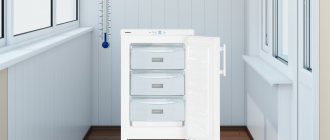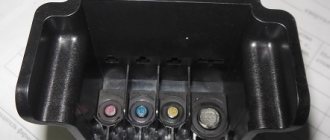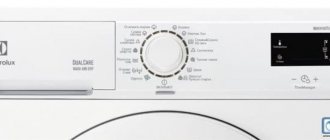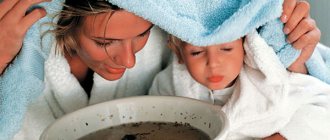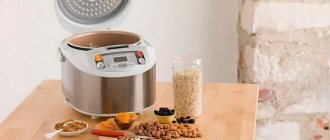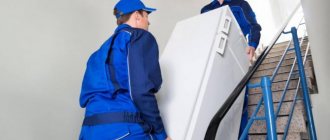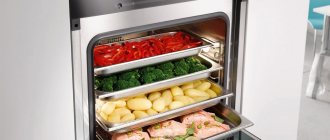Before purchasing a nebulizer and inhaler, be sure to consider the particle size, number of masks, noise level, and form factor. The most modern are Mesh nebulizers, the loudest are compressor models. Steam inhalers can only treat the upper respiratory tract. The optimal aerosol spray rate for an adult is 0.25-0.5 ml/min, for a child – 1-2 ml/min. The best manufacturers: Omron, A&D, Microlife, B. Well, MED2000, Little Doctor.
For colds, inflammation of the lungs and bronchi, inhalers or nebulizers quickly and effectively deliver medications to the respiratory organs. With their help, you can stop or completely stop the development of inflammatory processes. Medicinal substances enter directly into inflamed areas, relieve swelling, moisturize mucous membranes, and thin sputum.
Go straight to the rating =>
Attention! Never use nebulizers and inhalers without consulting a doctor and without studying the instructions in detail! Failure to comply with the requirements may cause serious consequences!
The rating of the best inhalers and nebulizers , compiled based on user reviews and the opinions of expert doctors, will help you choose the right device.
We have previously written about:
14 Best Oral Irrigators
Types of inhalers
Modern inhalers come in the following types:
- Steam . Pharmaceuticals, herbal decoctions, mineral water, and essential oils are heated to steam.
- Compression . The medicine is broken into small particles using a unit that blows air. Do not use herbal infusions and oils.
- Ultrasonic . Under the influence of waves, drugs are converted into small particles. Hormonal, antihistamines, oils and herbs, some types of antibiotics are not used.
- MESH nebulizers . With the help of a special vibrating membrane, the medicine breaks down into finely dispersed parts, passes through the filter and enters the respiratory system. Essential oils and decoctions will damage the device.
- Spacers . Designed to filter large drug particles, slow down the flow rate. Used in combination with an aerosol inhaler in the complex treatment of asthma or obstructive bronchitis.
Rules for using inhalers:
- start inhalation no earlier than 1.5 hours after eating and performing serious physical activity;
- during the procedure, do not be distracted by reading or talking;
- Clothes should not restrict the neck area
- for diseases of the nasopharynx, nose or paranasal sinuses, it is recommended to inhale through the nose using a mask or special nozzles
- for diseases of the pharynx, larynx, trachea, bronchi and lungs, you should inhale through your mouth, you need to breathe evenly.
- before inhalation, you should not take medications that improve sputum discharge
- rinse your mouth with antiseptics before inhalation
- After inhalation, you must rinse your mouth with water at room temperature
- if a mask was used for inhalation, it is also necessary to rinse the face and eyes
- Inhalations with medications should be carried out up to 3 times a day
Why it is not recommended to use essential oils during nebulizer therapy - because fats can settle on the walls of the bronchi and alveoli, which leads to impaired gas exchange, even leading to pulmonary edema.
The difference between inhalers and nebulizers, which is better?
Inhalers are devices for introducing a drug into the respiratory tract by heating it and converting it into vapor droplets. Nebulizers use ultrasound, a compressor, and a membrane to break the medicine into tiny particles. They provide not a drip, but an aerosol method of administering the product. Steam inhalers can only treat the upper respiratory tract.
When using nebulizers, the medicine enters the lower respiratory tract. Which one is better to buy, you choose depending on the disease.
How to use an aerosol inhaler
Aerosol inhalers belong to the pocket category and are very easy to use:
- Turn the can over.
- Shake it several times.
- Insert mouthpiece into mouth.
- Press it and at the same time take a deep breath.
The drug is immediately sprayed into the throat and enters the respiratory tract. After inhaling, it is recommended to hold your breath for a few seconds to allow the medicine to penetrate deeper into the pathological focus.
Can essential oils and herbal infusions be used in nebulizers?
Nebulizers, unlike steam inhalers, create particles that can penetrate the lower respiratory tract and even the alveoli. When oil particles penetrate into this section, it provokes blockage of the bronchi and leads to severe pneumonia! The situation is similar with decoctions and infusions. Herbs are a strong allergen, which, if it enters the lower respiratory tract, can cause severe swelling and an allergic reaction, leading to serious consequences!
But there is an exception. If the nebulizer has different modes and particle size adjustment, for example, like the flem nuova delphinus f1000, then when using a special nozzle, particles will be created that are not able to pass into the lower section. But before use, be sure to consult your doctor!
Which particle size is best?
For the treatment of respiratory diseases, it is important to select the correct particle sizes:
- 5-10 microns for the treatment of diseases of the larynx, oropharynx, trachea;
- 2-5 microns for drug delivery to the lower respiratory tract;
- 0.5-2 microns for drug deposition in the pulmonary alveoli.
High-quality models are available with the ability to adjust these indicators from 0.5 to 10 microns.
A nebulizer with a particle size of 2-5 microns is considered universal.
Which nebulizer to choose based on operating principle
When choosing a product, you must consider the following points:
- Steam inhalers will help with damage to the larynx and trachea, but are not effective for bronchial asthma. Antibiotics, hormonal, and mucolytic agents must not be loaded into the container.
- Compression nebulizers are indicated for the treatment of diseases of the oropharynx and nasopharynx, asthma, and bronchitis. They work noisily.
- Ultrasonic devices provide high quality dispersion and deliver a healing solution to all parts of the respiratory system. Not suitable for all medications.
- Spacers allow you to inject one or two doses of the drug and stop an attack. Not suitable for a full procedure.
- Drug savings will be ensured by devices that regulate the supply of medication during inhalation and cessation during exhalation.
- The aerosol spray rate for a child is 1-2 ml/min, for an adult – 0.25-0.5 ml/min.
The quietest are MESH nebulizers, the noisiest are compressor devices.
The best manufacturers of inhalers and nebulizers
The following manufacturers have proven themselves well:
- Omron . The largest Japanese electronics corporation produces highly effective nebulizers. The advantages of the products include low noise and durability. The disadvantages include the high cost.
- Microlife . The headquarters of the global brand for the production of high-quality medical equipment are located in Switzerland, Italy and the USA, production facilities are in China. Nebulizers are affordable and easy to operate.
- B. Well . The European company creates household medical devices and health products. The brand produces many models of compressor, ultrasonic, membrane nebulizers, and steam inhalers. The devices are valued for their high quality of performance and effectiveness.
- A&D Medical . World-famous Japanese manufacturer of compressor, ultrasonic and mesh nebulizers. One of the most successful models was a nebulizer for children with a dolphin design.
How to do therapeutic inhalations correctly
Therapeutic inhalations are one of the most effective methods of treating respiratory diseases in children and adults. With the help of inhalations, local treatment of the oropharynx and respiratory organs can be effectively carried out without significant systemic side effects.
Along with the chemical factors of treatment, physical factors of therapy (humidification, warming of inhaled air) are of great importance. Substances used by inhalation are delivered directly to the site of the disease in maximum concentration and for a long period of time.
We can distinguish types of inhalations depending on the physical state of the inhalation environment:
- Dry inhalations (haloneb inhaler, Salitair saline inhaler);
- Wet (compressor, ultrasonic, MES inhalers, steam, cold-wet);
- Gas (helium, oxygen, ozone, xenon, nitrous oxide).
Based on the point of application, three zones of influence can be roughly distinguished:
- Zone of bronchioles and small bronchi (ultrasound, MES inhalers);
- Zone of medium caliber bronchi (compressor, saline);
- Area of large bronchi, trachea and organs of the oropharynx (steam, cold-wet inhalers, saline).
The effectiveness of inhalations consists of physical and chemical factors of influence.
Physical effects of inhalation:
- Moisturizing mucous membranes, improving sputum fluidity (liquefaction);
- Expansion of the airways;
- Changes in the speed and nature (turbulent, laminar) of air flow.
Chemical effects are determined by the components of inhalation:
- Mucolytics (agents that improve sputum drainage);
- Bronchodilators (bronchodilators);
- Anti-inflammatory drugs (glucocorticoids, antihistamines, membrane stabilizers);
- Anti-infective.
Types of inhalers
The advantages of ultrasonic inhalers are low operating noise, high dispersion and stability of the aerosol. To increase the stability of the aerosol, nebulizer-type attachments are used. The average size of aerosol particles during ultrasonic and compressor inhalations is less than 5 microns.
The disadvantage of ultrasonic inhalers is the destruction of some substances for inhalation (in particular medications), and the impossibility of inhalation with essential oils. The disadvantage of a compressor inhaler is noise. The MESH inhaler is silent, produces a stable aerosol, does not destroy medications, is lightweight, can be used while tilted and while the child is sleeping, but is expensive.
Ultrasonic, compressor, MES inhalers are necessary for obstructive bronchitis, chronic obstructive pulmonary disease, bronchial asthma and pneumonia. They produce an aerosol with a particle size of less than 5 microns with the possibility of affecting the deep parts of the respiratory system.
It must be said that in everyday life in 80 - 90% of cases you will need a simple steam inhaler. Most often, colds are limited to the upper respiratory tract (oropharynx, nose, sinuses, larynx). Bronchitis, tracheitis, and pneumonia are much less common. Therefore, the main point of action for colds and acute respiratory viral infections is the upper respiratory tract. This is where the aerosol from steam inhalers settles. By itself, steam inhalation of a solution of sodium chloride (table salt) is very effective in treating colds in children and adults.
In the treatment of false croup (inflammatory narrowing of the larynx during ARVI), cold-moist oxygen inhalations are effective.
Special attachments for inhalers allow inhalation with increased effects on the paranasal sinuses (for example, PARI SINUS).
Portable pocket inhalers are available in pharmacies in the form of ready-made aerosols (mainly bronchodilators).
Among dry salt inhalers, we can roughly distinguish coarse (Salitair) and fine (Haloneb). For inhalation, regular table salt is used; you can use sea, Himalayan or other types of salt. Coarse salt inhalers are very effective in treating diseases of the nose and oropharynx, ARVI, and colds (by the way, you can make a dry salt inhaler yourself from an ordinary coffee grinder, loading it with salt - according to Bolotov).
Fine aerosols are produced by the ultrasonic dry-salt haloinhaler “Galoneb” (salt cave air). The aerosol of this inhaler reaches the small bronchi and bronchioles. Therefore, it is effective for chronic bronchial diseases (bronchial asthma, obstructive bronchitis, smoking, occupational hazards). The Galoneb inhaler is also effective for preventing frequent exacerbations of diseases of the oropharynx and respiratory organs (rhinitis, sinusitis, pharyngitis, bronchitis). Dry inhalations very effectively thin mucus and improve its drainage. They are especially effective for chronic diseases of the respiratory system and oropharynx in adults and children. Dry salt inhalations expand the airways and have an anti-inflammatory and antimicrobial effect.
Oxygen inhalation is effective for many chronic and especially acute diseases of the respiratory system. Oxygen eliminates hypoxia and normalizes blood circulation. Hypoxia (oxygen deficiency) is a universal pathological condition in all diseases of the respiratory system, so its elimination always alleviates the patient’s condition.
Helium significantly increases the fluidity of the air flow, so the helium-oxygen mixture freely penetrates into all parts of the lungs, eliminating oxygen starvation, especially with pathological narrowing of the airways (obstruction). Oxygen therapy and helium inhalation are carried out mainly in a hospital setting. Small oxygen canisters for short-term inhalations are available in pharmacies.
Basic chemicals for inhalation.
Pharmacological effects are determined by the chemical structure of the inhaled drug. It must be said that some drugs act differently when inhaled than through other routes of administration. For example, furosemide administered intravenously increases diuresis, and inhalation dilates the bronchi.
- Bronchodilators: Berodual, Atrovent;
- Inhaled glucocorticoids: pulmicort, budenide;
- Mucolytics and mucokinetics (thinning sputum): ambroxol, acetylcysteine, carbocysteine;
- Membrane stabilizers: intal, tiled, ketotifen;
- Combined-action drugs (herbal preparations, aromatic oils).
Inhalation technique
Inhalations are done 1 - 1.5 hours after meals. During inhalation, you need to concentrate on the procedure itself and inhale and exhale the aerosol correctly. For diseases of the nose and paranasal sinuses, inhalation vapors are inhaled and exhaled through the nose. When coughing or having a sore throat, inhale and exhale through the mouth.
After a deep breath, you need to hold your breath for 1-2 seconds, then a calm, complete exhalation follows. Inhalations are done for 3 to 5 minutes. Inhalations should be carried out 3 to 10 times a day (every 2 hours). The course is at least 5 days (usually 10 days).
The best compressor nebulizers
1
Omron Comp Air NE-C300 Complete
Rating:5.0
- attachments: adult mask, mouth attachment, children's mask, nose attachment
- particle size adjustment
- spray rate: 0.7 ml/min
- medicine container volume: 12 ml
- power supply: mains
Average price: 5,250 rub.
The leader in the rating of compressor nebulizers is a universal device that will help you quickly get rid of the first symptoms of a cold and cure existing diseases. Depending on the chosen mode, the medicine is delivered to the upper, middle or lower respiratory tract.
Peculiarities:
- three inhalation modes for different parts of the respiratory tract;
- convenient adjustment of spray speed;
- large container for medicine.
The inhaler can be used for a wide range of diseases, including acute respiratory viral infections, tonsillitis, rhinitis, and sinusitis.
2
Omron Comp Air NE-C28
Rating:4.9
- attachments: adult mask, mouth attachment, children's mask, nose attachment
- average particle size: 3 µm
- spray rate: 0.4 ml/min
- medicine container volume: 7 ml
- power supply: mains
Average price: 6,590 rub.
Another high-quality nebulizer from Omron is not so compact, but is also highly reliable. Masks of different sizes for children and adults are included. To prevent the child from being frightened by the noise, the kit includes a long tube. Thanks to the breath-activated chamber, medication consumption is economical. The manufacturer managed to combine optimal air flow with the size of the sprayed particles.
Model features:
- masks of different sizes for adults and children;
- you can breathe through your nose and mouth, depending on the location of the disease;
- Convenient carrying bag where you can put the device and all accessories.
During the epidemic, the whole family can use the device. Patients with asthma also appreciated the advantages of the device.
3
Little Doctor LD 212C
Rating:4.8
- attachments: adult mask, mouth attachment, children's mask, nose attachment
- particle size adjustment
- spray rate: 0.5ml/min
- medicine container volume: 10 ml
- continuous operation time: 20 min
Average price: RUB 2,050
The price tags for Omron nebulizers are not very pleasing to buyers. For those looking for an inexpensive option, we recommend taking a closer look at the best device in this segment from the Taiwanese manufacturer Little Doctor. For an affordable price, the user receives a breath-activated nebulizer with three nozzles.
Model features:
- small residual volume of solution at the end of the procedure;
- selective therapeutic effect, depending on the selected nebulizer;
- a wide range of medications is allowed;
Judging by numerous user reviews, this model has the best price-functionality ratio.
4
B.Well MED-121
Rating:4.7
- attachments: adult mask, mouth attachment, children's mask
- average particle size: 3 µm
- spray rate: 0.3 ml/min
- medicine container volume: 5 ml
- continuous operation time: 30 min
Average price: 3,110 rub.
Unlike the previous nebulizer, which uses traditional technologies, MED-121 is equipped with an innovative “Famili” nebulizer. The strength of the medication flow will depend on which family member is using the device. A nebulizer from a European manufacturer makes it possible to use medications of different viscosities.
Peculiarities:
- suitable for any user, regardless of age;
- can be used in the treatment of bronchial asthma;
- The device operates without interruption for 30 minutes.
A nebulizer from B.Well will help you carry out high-quality therapy for the lower respiratory system at home.
5
A&D CN-233
Rating:4.6
- attachments: adult mask, mouth attachment, children's mask
- average particle size: 3 µm
- spray rate: 0.25 ml/min
- medicine container volume: 6 ml
- continuous operation time: 30 min
Average price: 2,470 rub.
A practical nebulizer model for the treatment and prevention of respiratory diseases in children and adults. Equally suitable for treating all parts of the respiratory tract. The evaporation of the liquid occurs quickly and allows the procedure to be carried out effectively.
Peculiarities:
- the device generates a universal particle size;
- many masks included, additional ones can be purchased at the pharmacy;
- The device does not need a break, there is protection against overheating.
The Japanese nebulizer is quite bulky and heavy. If you need a portable device, we recommend that you pay attention to the previous model of the B.Well rating MED-121.
6
Flaem Nuova Delphinus F1000
Rating:4.5
- attachments: adult mask, mouth attachment, children's mask, nose attachment
- particle size adjustment
- spray rate: 0.5ml/min
- medicine container volume: 8 ml
- continuous operation time: 60 min
Average price: 4,707 rub.
The multifunctional nebulizer belongs to the category of professional medical equipment. It is used not only at home, but also in health resorts and medical institutions. You can load oil solutions, antiseptics, antibiotics, mineral waters, and other products without visible large particles into the container. Different drugs require different nozzles, so oil medicines are used to treat the upper respiratory tract, you need to use a special nebulizer nozzle with it.
Peculiarities:
- equipped with masks and attachments for children and adults;
- can be used by the patient in any position, including lying down.
- works continuously for up to 60 minutes, which allows for long-term effective procedures.
Users note some difficulties in using the device independently. Before use, you must carefully study the instructions.
7
B.Well WN-117
Rating:4.4
- attachments: adult mask, mouth attachment, children's mask
- average particle size: 4 µm
- spray rate: 0.3 ml/min
- medicine container volume: 13 ml
- continuous operation time: 30 min
Average price: RUB 2,166.
The compact nebulizer is equipped with a large internal reservoir for medicines. It is convenient to measure the refill using the scale on the flask. The device can be used by children and adults. It differs from the previous model in its budget price and simple controls.
Model features:
- an intuitive control system that even a child can understand;
- consumables, including filters, are included in the kit;
- The parts of the device can be easily disassembled for washing and storage.
The generated particles penetrate into the pulmonary alveoli. The device allows you to treat the upper and lower sections of the respiratory system.
8
ARMED 403V
Rating:4.3
- attachments: adult mask, mouth attachment, children's mask
- average particle size: 4 µm
- spray rate: 0.1 ml/min
- medicine container volume: 6 ml
- continuous operation time: 30 min
Average price: RUB 2,312.
In eighth place is an inhaler for home, which is positioned by the manufacturer as a reliable and safe device for use by all family members. For ease of carrying, the device is equipped with a handle on the body. Starts with the press of one button.
Peculiarities:
- a powerful compressor ensures effective procedures;
- particle size is adjustable from one to six microns;
- It is not prohibited to use antibiotics, antiseptics, hormonal, steroid and mucolytic agents.
The device shows high efficiency in the treatment of laryngitis, rhinosinusitis, tuberculosis, tracheitis, and many other diseases of the bronchopulmonary system.
Spacers and inhalers: what are they and how to choose the right device?
From autumn to spring, we get sick more often and diseases such as acute respiratory viral infections and acute respiratory infections top the anti-rating. Some periodically suffer from rhinitis, pharyngitis, laryngitis and sinusitis, and some need maintenance therapy on an ongoing basis - we are talking about such serious illnesses as bronchial asthma, chronic obstructive pulmonary disease or cystic fibrosis.
For each of the listed diseases, treatment is provided with a specific set of medications, but they have one thing in common - when the effectiveness of treatment is important, an inhaler, or, as it is also called, a nebulizer, comes to the rescue. We tell you what a “nebulizer” and a “spacer” are, what devices are popular and what models we trust.
What is a nebulizer?
A nebulizer is a device that facilitates rapid transportation of drugs to the most distant parts of the bronchial tree. In liquid form, drugs are placed in the chamber of the device and, under the influence of compressed air, are broken into small particles. The person can only inhale the aerosol through a mask or mouthpiece.
Unlike treatment with injections and tablets, medications for inhalation are practically not absorbed into the blood and do not have side effects. On average, the course of treatment is 5 days, but according to the doctor’s prescription it can be increased
Why is a compressor nebulizer better?
Compressor nebulizers are universal, as they allow you to treat with almost any drug*.
And also: - the size of particles converted by the device can be increased or decreased using filters, which is especially important for the treatment of various types of respiratory diseases; — the simplicity of the design makes the device durable and reliable: it does not require any special care, and in order to disable it, you will need to make an effort.
Which nebulizers do customers like?
First of all, these are universal compressor devices from Omron.
With their help, the patient can receive treatment with a wide range of medications. Combined with a large selection of modifications for home use, simplicity, efficiency and reliability, OMRON inhalers have gained popularity among customers of the FARMEKONOM pharmacy chain. Compressor-type inhalers from OMRON
NE-C20 is one of the most compact and quiet nebulizers from Omron, which is also inexpensive.
OMRON C21 Basic makes virtually no noise and the least amount of medication remains in it after the session. This is the second small device after the NE-C20, but, unlike it, it has an undoubted advantage - due to a more powerful compressor, it turns the medicine into an aerosol with extremely small particles - from 2.5 microns and does it faster, which reduces the standard procedure time by 25%. Unlike previous models, the manufacturer has implemented virtual valve technology** in the NE-C24-RU. This device produces even smaller drug particles, but takes up a little more space. NE-C24-Kids, identical in technical characteristics, is designed specifically for small patients - in the delivery set you will find bright mask attachments in the form of a bear and a rabbit. Although the NE-C28-RU ComAir inhaler is compact, compared to other devices from the Omron line, it is larger in size and weight due to the built-in cooling system. It allows the device to work almost continuously, which is especially important for chronic patients, large families and even for medical institutions. The noise from the device is compensated by an almost twice as long air tube.
The nebulizer chamber is responsible for “grinding” drugs. You need to change it to a new one once a year, as the manufacturers recommend. Untimely replacement leads to a decrease in the effectiveness of inhalations or makes them impossible. In the assortment of the online pharmacy FARMEKONOM you will find a nebulizer chamber with a mouthpiece for Omron NE-C28, NE-C29 and NE-C30 inhalers.
Characteristics of OMRON nebulizers
| Main characteristics: | OMRON device models | ||||
| NE C 20 | OMRON C 21 Basic | NE C 24 RU | NE C 24 Kids for children | NE C 28 RU ComAir | |
| VVT Virtual Valve Technology: | — | — | + | + | + |
| Network operation: | — | — | + | + | + |
| Average aerosol particle size: | 3 µm | 2.5 - 4.5 µm | 3 µm | 3 µm | 3 µm |
| Medicine tank volume: | 2-10 ml | 2-10 ml | 2-7 ml | 2-7 ml | 2-7 ml |
| Residual volume of medicine: | 0.7 ml | 0.5-1 ml | 0.7 ml | 0.7 ml | 0.7 ml |
| Noise level: | 45 dB | 45 dB | 46 dB | 46 dB | 60 db |
| Aerosol % < 5 µm: | 72 % | 63 ± 10 % | 70 % | 70 % | 76 % |
| Air tube length: | 100 cm | 100 cm | 100 cm | 100 cm | 207 cm |
| External dimensions (width x height x depth): | 85mm x 43mm x 115mm | 85mm x 43mm x 115mm | 142mm x 72mm x 98mm | 142mm x 72mm x 98mm | 170 mm x 103 mm x 182 mm |
| Contents of delivery: | compressor, nebulizer chamber, air tube (PVC, 100 cm), mouthpiece, nose piece, adult mask (PVC), child mask (PVC), 5 spare air filters, AC adapter, storage bag, instruction manual , warranty card. | compressor, nebulizer chamber, air tube (PVC, 100 cm), mouthpiece, nasal nozzle, mask for adults (PVC), mask for children (PVC), power adapter (HHP-CM01), spare air filters (5 pcs.) , storage bag, instruction manual, warranty card | compressor, nebulizer chamber, air tube (PVC, 100 cm), spare air filters - 5 pcs. , Mouthpiece, Adult Mask (PVC), Child Mask (PVC), Nosepiece, AC Adapter, Storage Bag, Instruction Manual, Warranty Card | compressor, nebulizer chamber, children's accessories (happy bear, happy bunny), air tube (PVC, 100 cm), spare air filters - 5 pcs., mouthpiece, adult mask (PVC), infant mask (PVC), mask for children (PVC), AC adapter, storage bag, instruction manual, warranty card. | storage and carrying bag, mouthpiece, adult and children's masks, nose piece, set of filters, extended air tube (207 cm), instruction manual, warranty card. |
It is worth noting that all medical devices from Omron boast modest size, light weight and a small volume of medicinal residues. The components of each of the listed devices, such as a mask and a nebulizer chamber, can be disinfected using boiling or chemicals.
The best*** models of compressor-type nebulizers from Little Doctor
Little Doctor compressor inhalers practically do not limit users in the number of suitable medications. From the manufacturer’s line, we chose 2 really good devices: - lightweight LD 212C, which works for up to 20 minutes without a break and produces a minimum of noise; — LD-211C which is 620 grams heavier than the previous model, but with continuous operation time increased to 30 minutes. The noise level it produces does not exceed a comfortable level.
Characteristics of Little Doctor nebulizers
| Main characteristics | Little Doctor models | |
| LD-212C | LD-211C | |
| Maximum continuous operation time: | 20 minutes. | 30 min |
| Average aerosol particle size: | A - 3.5; AT 4; C - 5 µm | A - 3.5; AT 4; C - 5 µm |
| Medicine tank volume: | 10 ml | 10 ml |
| Residual volume of medicine: | 0.5 ml | 0.5 ml |
| External dimensions: | 130 x 205 x 95 mm | 175 x 150 x 105 mm |
| Inhalation activation: | Yes | Yes |
| Additional benefits: | The set includes a children's mask and 3 nebulizers: A - for the lower respiratory tract; B - universal sprayer; C - for the upper respiratory tract | Suitable for home and clinic, has a detachable container for storing accessories, comes with two masks, including a baby mask, and three types of sprayers: A, B and C. |
| Noise level: | 55 dB | 65 dB |
| Weight, g: | 1270 | 1890 |
| Power consumption: | 60 W | 60 W |
One of the main advantages of Little Doctor medical products is the inhalation activation function, due to which the aerosol is intensively released when air enters the lungs, but not at the moment of exhalation, as happens when using direct-flow or convection inhalers. Activation during inspiration can reduce drug consumption by 70%, which increases the effectiveness of treatment.
Compressor inhaler AND
Nebulizer AND CN-233 is a simple, reliable and inexpensive device for inhalation that can work for up to 30 minutes, after which you need to take a half-hour break. There are devices for stability in the lower part, so you don’t have to worry about an accidental fall. In addition to the main unit, in the package you will find: two types of masks (for children and for adults), 5 air filters and other accessories. The medium-noise device (60 dB) has small dimensions, only 150x140x90 mm, and weighs about 1200 grams. It generates particles ranging in size from 0.5 to 10 microns (average 4 microns) and atomizes them at a rate of 0.25 ml per minute.
When using compressor nebulizers, you must not:
- independently change the treatment regimen, including exceeding the dosage of medications; - use medications intended for inhalation; — turn on the device without liquid; — move, shake and tilt it during use; - leave workers unattended.
Rules for inhalation
Concentrate on the process: do not talk during the procedure, do not eat food 1 - 1.5 hours before and after inhalation, do not go out into the cool air for one hour after the session.
| Location of the problem | How to breathe and what devices to use when inhaling and exhaling | Breathing pattern |
| nose, paranasal sinuses, nasopharynx | through the nose using a mask | calm breathing without tension |
| throat, larynx | through the mouth with a mouth guard or mask | calm breathing as usual |
| trachea, bronchi, lungs | with mask or mouthpiece | smooth, deep breathing |
What are spacers?
A spacer is a compact auxiliary device for the treatment of bronchial asthma. It consists of a chamber for the medicine and a nebulizer, which reduces the particles of the spray to microscopic sizes. In this form, the active components of the drug reach the lower sections of the bronchi, directly to the source of inflammation, and begin to act instantly.
What is the value of spacers?
Despite its apparent simplicity, a pocket inhaler can cause difficulties at the time of use. The fact is that the medicine in the bottle is under pressure and when the valve is pressed, it is released at tremendous speed.
Thus, some adults with bronchial asthma cannot always cope with jet inhalers, not to mention children who find it difficult to explain the principle and sequence of actions.
Taking the drug from an inhaler is actually fraught with difficulty, because it involves exhaling air from the lungs and sharply inhaling a volatile spray as the valve on the bottle is pressed. A patient with bronchial asthma tries to catch up in a split second, which is why his breath becomes convulsive, and the medicine gets not so much into the lower sections of the bronchi, but into the larynx.
Spacers simplify the procedure for taking medication from a bottle by allowing the inhalation and injection of the medication to be unsynchronized. It turns out that the patient inhales the fine suspension for as long as he needs.
Which spacer has the best combination of price and quality?
The American-made OptiChamber Diamond device is suitable for you. Its chamber is made of antistatic material, which prevents rapid inhalation of the aerosol, and the LiteTouch VHC mask prevents the drug from evaporating, which improves the quality of therapy.
For children there is a low resistance valve system. This means that even with little effort, the drug will enter the respiratory tract. The valve is clearly visible, so parents can track the number of breaths the child takes and the time he holds his breath. The ideal spacer for a growing family member is the OptiChamber Diamond with a children's mask.
The online pharmacy catalog and the FARMEKONOM pharmacy chain offer inhalers and spacers at super competitive prices. For buyers, we have collected the best, in our opinion, models of devices for use at home: high-quality, reliable, inexpensive, with simple, intuitive controls.
You can order all the devices listed here right now on this website. Don't delay your purchase, start saving!
There are contraindications. Before purchasing, consult your doctor and read the instructions for use
* excluding oil-based medications (especially essential oils) ** innovative OMRON system, which replaced the silicone inhalation and exhalation valves. *** according to buyers of the online pharmacy and the pharmacy chain FARMEKONOM
The best children's inhalers and nebulizers
1
Omron Comp Air NE-C24 Kids
Rating:5.0
- attachments: adult mask, infant mask, mouthpiece, children's mask
- average particle size: 3 µm
- spray rate: 0.3 ml/min
- medicine container volume: 7 ml
- continuous operation time: 20 min
Average price: RUB 3,999.
The lightweight and compact children's nebulizer has a bright, interesting design. To keep children occupied during the session, two colored accessories in the form of a bear and a bunny are included. If you fix them with a mask or attachment, the treatment process will turn into a game for the child.
Peculiarities:
- the size of the sprayed particles and the flow rate are designed for the child’s body;
- suitable for children of any age, starting from infancy;
- almost silent operation, children are not scared.
Using the device, you can make inhalations with any drugs, except oils and herbal decoctions.
2
B.Well PRO-115
Rating:4.9
- attachments: adult mask, infant mask, mouthpiece...
- average particle size: 3.16 microns
- spray rate: 0.4 ml/min
- medicine container volume: 8 ml
- continuous operation time: 30 min
Average price: RUB 2,795.
European developers did not include gaming accessories, like Omron, but made the nebulizer itself in the form of a train toy. Real healing steam comes out of the pipe. Despite its “frivolous” appearance, the compressor device copes well with the treatment of diseases of the bronchopulmonary system in newborns, children of different ages and adults.
Peculiarities:
- thoughtful, lightweight design, nothing superfluous;
- the possibility of using medications of different spectrum of action;
- The device can be disinfected by boiling.
Children really like the design; they perceive the inhalation procedure as a game.
3
MED 2000 Pingoo U2
Rating:4.8
- nozzles: mouth nozzle, nose nozzle
- average particle size: 5 µm
- particle size adjustment
- spray rate: 0.7 ml/min
- medicine container volume: 4.5 ml
Average price: RUB 3,086.
Children's nebulizer , designed in the shape of a cheerful penguin, operates on the basis of ultrasonic technology and is completely silent. Holds 3.5 ml less medication than the previous model. Used to treat all parts of the respiratory tract.
Peculiarities:
- equipped with a timer and air flow regulator;
- works with any water-based solutions;
- equipped with three operating intensity modes.
The lightweight and convenient device can be used at home and while traveling.
4
MED2000 Cow
Rating:4.7
- attachments: adult mask, children's mask
- medicine container volume: 80 ml
- continuous operation time: 8 min
Average price: RUB 2,175.
A compact steam inhaler in the shape of Buryonka evokes positive emotions in children. It works according to the good old principle that our grandmothers used to treat their children, forcing them to breathe over the steam of boiled potatoes.
Peculiarities:
- relief of symptoms occurs 5-7 minutes after the start of inhalation;
- produces steam at a stable temperature of +43℃;
- Small dimensions and light weight allow you to take the device on trips and use it as first aid for colds.
This children's device does not have as many functions as the previous model, but with its help you can quickly relieve the symptoms of bronchitis, flu, laryngitis, sinusitis, and seasonal allergies.
The best electronic mesh (mesh) nebulizer
1
Xiaomi Andon VP-M3A
Rating:5.0
- attachments: adult mask, mouth attachment, children's mask
- spray rate: 0.2 ml/min
- medicine container volume: 8 ml
- power supply: batteries, mains
- noise level: 50 dB
Average price: 3,500 rub.
The Xiaomi nebulizer was developed with the participation of leading pulmonologists. It has a beautiful design and miniature dimensions. Easy to use and turns on at the touch of a button. Produces a low-disperse aerosol that can penetrate deep into the lungs.
Peculiarities:
- equipped with masks of different sizes, can be used for the whole family;
- operates autonomously from a battery that is charged via a USB port;
- High quality of the product ensures long-term operation without breakdowns.
The device can be used for the prevention of acute respiratory infections, treatment of asthma, bronchitis, allergic manifestations in children, adults and the elderly.
2
AND UN-233AC-M
Rating:4.9
- attachments: adult mask, mouth attachment, children's mask
- average particle size: 2.1 microns
- spray rate: 0.2 ml/min
- medicine container volume: 8 ml
- power supply: batteries, mains
Average price: 6,090 rub.
The device is used for almost all pathologies of the respiratory system; contraindications are rare. Ensures that the procedure is carried out for 20 minutes, then you need to take a break. Thanks to its compactness and low weight, you can carry it with you in a handbag or carry it in the glove compartment of your car.
Peculiarities:
- when the medicine in the reservoir runs out, it automatically turns off;
- inhalations can be carried out with the device tilted;
- The container for the medicinal solution is hermetically sealed.
When choosing this device, you must take into account that the mesh membranes need to be changed from time to time; they are expensive. It is better to buy such a device for an adult who needs to carry out procedures not only at home, but on the road.
Mesh technology
The drug substance is converted into a fine aerosol, which passes through a special mesh membrane and vibrates under the influence of low-frequency ultrasound. The holes in the mesh membrane can be set to sizes less than 5 microns. Thanks to this membrane, the medicine reaches the lungs and bronchi. They work without noise just like an ultrasonic nebulizer. They can nebulize all types of medications, similar to compressor nebulizers. Therefore, it can be argued that the mesh nebulizer is the most advanced device that combines all the advantages of a compressor and ultrasonic nebulizer. The size of the mesh nebulizer is very compact, thanks to this, it can be used to perform inhalation in any position, which is very important for treating patients in a supine position and for treating small children.
Only the most effective mesh nebulizers have a mesh icon
The best ultrasonic nebulizers
1
Little Doctor LD-250U
Rating:4.8
- attachments: adult mask, mouth attachment, children's mask
- particle size adjustment
- spray rate: 1.5ml/min
- medicine container volume: 12 ml
- continuous operation time: 30 min
Average price: 3,390 rub.
The device is intended for inhalation at home and in physiotherapy rooms. The therapeutic solution is crushed into an aerosol and penetrates into the farthest parts of the respiratory tract.
Peculiarities:
- high spray speed and high aerosol flow force;
- large volume of medication tank (12 ml);
- There are no age restrictions on using the device.
Hormone therapy sessions for the treatment of bronchial asthma, antibiotics and a number of bacteriological drugs cannot be used on this device. For these purposes, other models from our rating are purchased (for example, AND UN-233AC-M or Xiaomi Andon VP-M3A).
2
Medisana Inhaler USC portable
Rating:4.7
- attachments: adult mask, mouth attachment, children's mask
- average particle size: 4.8 µm
- spray rate: 0.3 ml/min
- medicine container volume: 8 ml
- continuous operation time: 15 min
Average price: RUB 3,999.
Unlike the previous nebulizer, which is successfully used in physiotherapy rooms, the Medisana device is intended exclusively for home therapy of the respiratory system. It operates silently and uses almost all the solution in the tank.
Peculiarities:
- the device is powered by AA batteries and belongs to the mobile category;
- two types of inhalations are possible through a mask or mouthpiece;
- automatically turns off at the end of the session, no need to track the inhalation time.
The device effectively maintains health all year round and helps avoid more serious types of treatment.
3
Almaz Comfort-02 SMART
Rating:4.6
- attachments: adult mask, children's mask
- average particle size: 2.7 microns
- nebulization speed: 1ml/min
- medicine container volume: 14 ml
- continuous operation time: 10 min
- 26 people bought this product
Average price: 2,200 rub.
The device allows for inhalation and aromatherapy. You can load medicine into the container and perform full-fledged physiotherapeutic procedures for the lungs and bronchi. Aromatic oil is used as an antiseptic, sedative or tonic.
Peculiarities:
- the spray chamber is equipped with a backlight to control the level of the medicine;
- the ability to load a wide range of sprayed substances, solutions, decoctions;
- Heating the aerosol increases the comfort of the procedure.
The device can be used to treat seriously ill people during sleep. Local illumination on the nebulizer is sufficient for carrying out the procedure in a dark room.
***
The rating of inhalers and nebulizers is presented for informational purposes, informs about the capabilities of the devices and does NOT replace a mandatory consultation with a doctor.
How to use an inhaler at home: rules and algorithm
The algorithm for using an inhaler at home remains unchanged, but there are certain rules for carrying out manipulations outside a medical institution:
- Before introducing the medicinal solution into the nebulizer container, it must be warmed to room temperature.
- You should not eat food at least one and a half hours before inhalation.
- The break between procedures should be at least 2 hours.
- 2-3 hours before inhalation, you should not use antiseptic solutions that are used for gargling and rinsing the sinuses.
It must be remembered that it is forbidden to pour products containing essential oils into the nebulizer, because their particles will settle on the surface of the alveoli of the lungs and provoke the development of “oil pneumonia”.
Distilled, running and drinking water is prohibited, because inhalation with it often provokes powerful bronchospasm.
How to use the nozzles: what is a mouthpiece for, how to breathe through a mask
The nozzles should be used as follows:
- the mouthpiece is inserted into the mouth, it is needed for a more directed distribution of particles of the medicinal solution;
- the mouthpiece, which is located at the end of the mouthpiece, should be held tightly between the lips;
- The cannula is first inserted into one nostril, then moved to the other.
The mask is applied to the face, you should breathe through it evenly and deeply. Inhalations are performed through the mouth, exhalations through the nose, at the peak of inhalation it is necessary to hold the breath for 1-2 seconds.
How often can you use it, procedure time
The frequency of use of the nebulizer is every 2 hours, if the coughing attacks are intense and the doctor has not given other instructions regarding the use of medications. The general instructions indicate that 2-3 inhalations can be performed per day.
The procedure time ranges from 5-10 minutes, depending on the type of nebulizer and the speed of particle spraying. It is believed that the manipulation should be completed as soon as the medicinal solution in the device’s container runs out.
How to breathe through a mouthpiece correctly
It will be correct to breathe through the mouthpiece in the following mode:
- take a deep breath through your mouth;
- exhale fully through the nose.
This does not imply holding your breath, as in the case of inhalation with a mask.
How to care for the device
In order for the nebulizer to work for a long time and without breakdowns, you need to properly care for it:
- After each inhalation, the device should be cleaned. To do this, all removable parts are soaked in warm soapy water for 15 minutes. After the specified time, they are washed under cool running water and dried naturally (without wiping with a towel).
- Disinfection should be carried out once a week. To do this, you need to disassemble the tube and mask into all elements (separating the T-shaped connections), put them in a bowl and pour boiling water over them. After 5 minutes, drain everything, rinse with running cold water and dry.
It is better to store the nebulizer in a cloth or towel to prevent dust from settling on small parts of the device.
